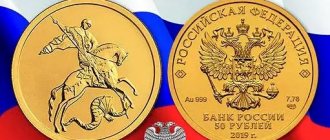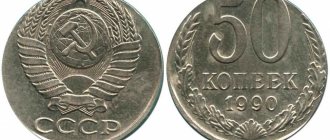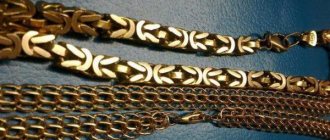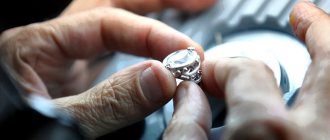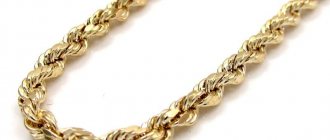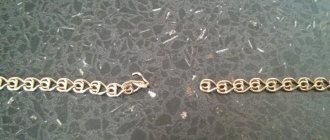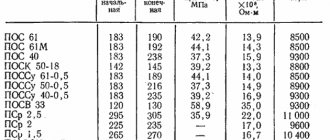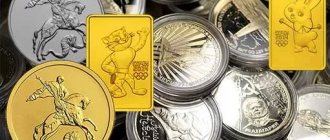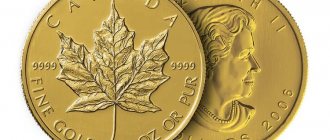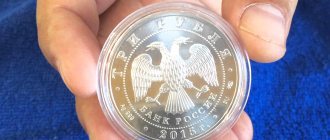What is the value and benefit
In the photo there is a gold coin of St. George the Victorious:
Denomination: 50 rubles. Made from high quality gold (999). This means that there is a lot of pure gold in it. There are no stone inserts, so hydroanalysis is allowed. In addition to the uncirculated quality, proof copies were issued (50 and 100 rubles).
Since the coin is an investment coin and not a collector's item, the premium on gold is lower. And transactions with investment items are not subject to value added tax.
The cost of producing the St. George the Victorious coin is low, and the circulation is large. The price is determined based on the value of the precious metal contained in the coin. Therefore, this coin is an excellent investment tool. The older the coin and the better preserved it is, the higher its price, and gold is becoming more and more expensive every year. Below you will see price dynamics. If you buy today, you can sell for much more later. In our store you can profitably buy gold coins “St. George the Victorious” of good quality.
Which banks buy coins from?
Are you wondering which banks buy coins? The purchase is carried out periodically, it is not permanent. That is, you cannot come and sell your coins at any time.
You can only sell investment coins made of precious metals – gold or silver – to the bank. However, their list is strictly limited; it can be found on the website of the Central Bank of Russia. Soviet, antique, foreign - not accepted!
When carrying out a transaction, the company will primarily focus on the condition of the object of sale. There are two states of coins that banks accept – anz and proof.
- Proof is an ideal condition, contained in a plastic capsule without scratches or other damage, with a mirror field and matte inscriptions.
- Antz is a coin with a matte or glossy field with an obligatory bright shine, where minimal damage is allowed.
Not long ago, SKB Bank announced that it was buying back 2002 coins issued by the St. Petersburg Mint. However, this action was more of an advertising nature, because The price offered by the organization was significantly lower than the market price.
Today, coins made of precious metals are bought:
- Sberbank of Russia,
- VTB 24,
- NOMOS-bank,
- Alfa Bank,
- Promsvyazbank.
Many Russians are interested in what Sberbank is buying this year? Today, the bank purchases only investment coins of its own issue, made of precious metals and produced in limited quantities.
Usually, during a purchase, Sberbank also purchases simple coins; for example, its catalog used to contain:
- copies produced in 2001 and 2003:
- 2001 – 50 kopecks, 1,2 and 10 rubles;
- 2003 - 1, 2 and 5 rubles, as well as 2 and 10 rubles in 2003 with Gagarin.
The emblem of the St. Petersburg Mint must be present on products made in 2003, except for copies with Gagarin, where it was not initially present. The total cost of coins purchased from the population, as a rule, does not exceed 5,000 rubles.
Also on our website there are articles about coins and rare coins that are currently in demand.
To view the catalog with photos and prices , you need to go to the official website of Sberbank using the link and go to the “Invest and Earn” section, “Coins and Bullions” category.
Before you go to the bank, find out how much you can get for your coins at various numismatic auctions and at a pawnshop
We have collected original reviews on this topic here, reviews from real people, many comments, worth reading.
If you want to find out where it’s better to invest your money to make money this year, then follow this link. If you are interested in deposits, then you can check out the best offers from banks here.
How much is the St. George the Victorious gold coin worth?
Since gold coins of this series are minted in large quantities, the price is formed based on the current quote of the precious metal on exchanges. It also matters how much the Central Bank asks for coins, since Sberbank purchases investment money from it for subsequent sale.
If you look at quotes for coins made of precious metals in excellent condition on the official website of Sberbank, you can see the following prices for the Victorious coin as of 09/04/2020:
- quality UC, purchase price - 44,600, sales - 34,000;
- PR quality, purchase price - 42,300, sale price not specified.
There are coins that have developed stains and signs of oxidation during storage. These defects are often due to manufacturing defects. If there are even minor abrasions, the coin loses value and its value may become significantly lower. For example, on the Sberbank website there are quotes for coins made of precious metals in satisfactory condition. There, the Victorious coin of PR quality already costs 38,100.
will help you invest only in good coins. By purchasing coins, you can invest in a reliable and liquid instrument.
It is important to be interested in the price of investment tokens immediately before purchasing them, that is, always look at the rate of St. George the Victorious gold coins for today, because the cost changes in accordance with the dynamics of stock exchange quotes.
Investment gold coin St. George the Victorious
St. George the Victorious, who slayed the serpent, can be found on coins of many countries (we did a special review about them), but today’s conversation is specifically about the Russian coin for investment. Before we start, let's remember the difference between collectible and investment coins. Collectible coins made of precious metals are minted in small quantities and in most cases are of “Proof” quality (mirror surface and matte relief). Bullion coins are minted in the usual quality and in much larger quantities. The main advantage of investment coins is the absence of value added tax on transactions with them. Since the Bank of Russia often writes in press releases that the next “... issue of the St. George the Victorious coin will make it possible to fully satisfy the demand for it from both investors and hoarders,” let us recall the difference between a hoarder and an investor. The first one simply seeks to protect his savings from depreciation by purchasing precious metals. The second one also seeks to make additional profit by playing on the rise or fall in the value of a particular metal on the stock exchange.
50 rubles “St. George the Victorious”
Coin of the first issue
As the Bank of Russia noted in the 2006 catalog, the issue of the gold investment coin “St. George the Victorious” sums up the era of the “chervonets” sale of 1975-1982. Indeed, after “Sower” was assigned investment status, its reserves, accumulated in the vaults of the Central Bank since the times of the USSR, gradually came to an end. Most of the credit institutions that were involved in the sale of “chervonets” became worried, because investors were in no hurry to take these coins back to the banks. Therefore, the resulting niche urgently needed to be filled with something. By this time, most modern foreign investment coins were made of pure gold (.999 or higher). LMD mastered the minting of coins from gold of the highest standard back in 1991, when several denominations of the “Russian Ballet” series were released in two versions: 585th standard (usual quality of minting) and 999th standard metal (“Proof”).
“St. George the Victorious” among the “Zodiac Signs”
We can say that the “test balloon” for the “Victorious” was the gold coins of the “Zodiac Signs” series of 2003-2005. What they have in common with the future “St. George the Victorious” is not only the 999 purity of gold and the usual quality of coinage (which is why many also classify them as investment coins), but also the rather modest filling of the reverse coin field. Place “St. George the Victorious” in a row with them, and he will look like the thirteenth sign of the zodiac. The design and sculpting of the model was carried out by People's Artist of Russia Alexander Vasilyevich Baklanov. The 50-ruble denomination was not chosen for the “Victorious” by chance: it is this one that is reserved by the Bank of Russia for coins weighing a quarter of a troy ounce of pure gold (7.78 grams). Since a small proportion of impurities is still present, the total weight of the coin is 7.89 grams with a diameter of 22.6 mm and a thickness of 1.6 mm. The edge contains 134 corrugations.
Two obverse options for 2009
The circulation of one and a half hundred thousand turned out to be small, and by the end of the first year of minting it was almost impossible to purchase “Victorious” in banks. The Bank of Russia took into account the interest in the new coin and sharply increased its circulation in subsequent years. The peak of minting occurred in 2009. With this date, Moscow coins are found in two versions: with a small mint mark size and with a large one. Considering that the small version of the sign was used in 2006-2007, and the large version appeared on coins with the date “2008”, researchers believe in the existence of the 2008 “Pobedonostsev” with a small sign. However, no one has actually presented such a coin yet.
Appearance of coins of Moscow (left) and St. Petersburg (right)
The Bank of Russia does not distinguish between MMD and SPMD coins, assigning them the same catalog number “5216-0060”. The same number accompanies the coin of various years of issue, regardless of the date on the obverse. Owners of “Pobedonostsev” easily distinguish Moscow coins from St. Petersburg coins: MMD has a matte surface and both the field and relief elements, while SPMD has a glossy-mirror-like relief in comparison with the matte field. However, of course, there is no question of minting the quality “Antiproof”.
Coin with a new obverse option
Since 2021, all Russian coins, including collectible and investment coins, will receive the State Emblem on the obverse instead of the emblem of the Bank of Russia. During this period, the minting of gold “Pobedonostsev” was temporarily stopped, so a new version of the obverse, developed by the artist E.V. Kramskoy and sculptor A.A. Dolgopolova, appears on these coins only in 2021.
Features of 2012 coins
100 rubles “St. George the Victorious” (Proof quality)
Coins with the date “2012”, minted as “Proof”, stand out from the general series. The Bank of Russia issued in this form not only the usual “Victory Bearers”, but also double coins - coins of a hundred-ruble denomination (15.55 grams or half a troy ounce of pure gold) with a total weight of 15.72 grams with a diameter of 30 mm and a thickness of 1.7 mm. No, these are not exactly the same “Victorious”. They were assigned other catalog numbers: 5216-0086 (50 rubles) and 5217-0039 (100 rubles). If we look at the catalog, we will see that this pair did not receive the status of investment coins. Each coin was issued in a circulation of 10,000 copies.
“St. George the Victorious” 2012, “Uncirculated” quality
However, there are also “Victory Bearers” with the date “2012” in the usual coinage quality, although they cannot be found in the same catalogue. It turns out that the Bank of Russia, regardless of the date, refers them to 2013. These “Victory Bearers” are already considered ordinary bullion coins.
"Mix-up" for metal
Much more interesting are coins with the same date, but issued in a different metal. At the auction, a silver-colored “Victorious” flashed in a weak state, which implies an inspection of a strange specimen by an expert numismatist. The auction description only states that the coin is made of copper-nickel alloy. Some consider this example to be a banal “custom” piece, while others continue to list it in the “Trial Coining” section. A gold-colored sample weighing 5.68 grams is also known. Considering that the weight of the steel ten with brass galvanizing is 5.63 grams with a diameter of 22 mm (slightly less than the “Victorious”), we can assume that during minting a blank was used specifically for it.
Circulation of gold coins "St. George the Victorious"
Since “Pobedonostsev” is bought not only by investors, but also by collectors, we present the circulation of these coins. After all, it is he who often determines the rarity of a particular coin. The values are taken from the catalogs of the Bank of Russia and may contradict the data once indicated in the plans of the Central Bank. For example, the circulation of the 2015 “Victorious” was previously determined by hundreds of thousands of copies, but as a result it was reduced to 30,000. And the 2021 coin with a circulation of “up to 500,000” was suddenly completely removed from the plan. Proof coins are not listed.
- 2006 (release date - February 1) - 150,000 units;
- 2007 (release date - January 9) - 500,000 units;
- 2008 (release date - January 9) - 630,000 units;
- 2009 (release date - February 2) - 1,500,000 units;
- 2010 (release date - January 11) - 650,000 units;
- 2013 (issue date - January 21) - 500,000 pieces (date “2012” on coins);
- 2014 (release date - December 26) - 300,000 units;
- 2015 (release date - July 24) - 30,000 pieces;
- 2018 (release date - August 30) - 150,000 units;
- 2019 (release date - January 9) - 300,000 pieces.
The Central Bank’s plan for 2021 states that “up to 500 thousand pieces” of gold “Pobedonostsev” will be produced, but we will only know the exact value when the catalog is released, which will happen next year. For 2021 and 2022 The circulation for this coin is currently indicated in a similar quantity.
Interesting facts about the golden “Victorious”
- Not only investors were delighted with the declared purity of the metal. There is talk in collecting circles that a significant part of the first issue was bought by jewelers and dental technicians, and then melted down by them for their needs. But perhaps this is only a justification to inflate prices for “Pobedonostsev” with the date “2006”.
- “St. George the Victorious” is a coin that combines both versions of the obverse of everyday Russian coins: the double-headed eagle (obverse of ruble denominations) and St. George the Victorious (obverse of denominations in kopecks).
- The minting of gold “Pobedonostsev” took 27 tons of pure metal (data for 2015).
- Circulation of gold “Pobedonostsev” from 2006 to 2021. inclusive amounted to 4,710,000 pieces (excluding “Proof”), and if the planned number of coins is minted in 2021, then their total number will exceed 5,000,000.
- Russian coins with the image of this saint are not the only ones among investment coins. On modern British sovereigns, minted in large quantities in normal quality, the defeated dragon is also struck by St. George the Victorious. However, on English coins he is armed not with a spear, but with a sword.
Packaging of gold "Pobedonostsev"
"Victorious" in capsule
It is important to know in what packaging the “Victorians” left the mint. Despite the fact that coins are considered investment coins, the price of which is determined by the value of their metal, some organizations strive to lower the redemption bar if the coin is not offered in the original capsule or without it at all.
- 2006 - a capsule with four “legs” holding the coin;
- 2007-2010 — a capsule with an inner circular rim the size of a coin;
- 2012 - anti-vandal capsule (capsule that breaks when opened) for the denomination of 50 rubles of any quality of coinage and a capsule with four “claws” for the denomination of 100 rubles;
- 2014-2015 — sealing in plastic sheets of 25 pieces (5x5);
- 2018-2019 - cardboard boxes with bridges separating coins from each other.
However, the 2021 “Victory Bearers” are also available in packs of 20 coins (4x5). Additional packaging for the Victorious coins was provided by one of the companies that sells and buys coins made of precious metals for greater safety.
Security of investment coins
Having paid attention to the safety of the original packaging, one cannot help but say about the degree of safety of the coins themselves. For example, Sberbank, if a scratch, stain or abrasion is found on it, puts it in the “discounted coins” category and buys it back at a large discount.
Coin with rust stains
An unexpected problem for investors was caused by the “Victorious” SPMDs of the early years of issue, on which rust spots gradually appeared, not only spoiling the impression of the coin, but also raising legitimate doubts about the declared purity of the metal. Most organizations refused to buy back such specimens at the price of coins without defects. For example, a resident of Ulan-Ude, who discovered rust stains on all five coins purchased several years ago, took them to Sberbank. The department was surprised, opened one capsule and even scratched the coin with something to check, but refused to buy the Pobedonostsev at the price list. In response to the complaint, the bank service indicated: “The reasons for possible defects could be either increased air humidity and high temperature conditions in the place where the coin was stored, or the opening of the protective capsule.” On the organization’s website, in a memo about storing coins, you can read: “We strongly do not recommend touching the coin with your hands, since the fingerprint left on its surface is practically impossible to remove. Even if the trace is successfully cleaned, it is possible that fatty residues invisible at first glance will enter into a chemical reaction with the composition of the surface of the coin, and later oxidation spots will appear in this place.” However, all this applies to “Proof” coins, and gold of ordinary minting quality can withstand the touch of fingers without such horrific consequences.
Coin with minor defects
Judging by the fragments of the coin shown above, on the St. Petersburg “Pobedonostsy” one can find not only rust, but also green spots. Perhaps all this would have remained a personal tragedy for everyone who once chose to invest in Russian monetary gold if the famous shocking businessman German Sterligov had not joined the process, who also discovered rust on the purchased “Pobedonostsy”. Over time, the Bank of Russia admitted that the coins could have hidden defects in the form of foreign microparticles, which turned out to be susceptible to oxidation. However, the Central Bank did not buy back the coins, since it does not carry out transactions for the sale and purchase of coins made of precious metals. If you find traces of oxidation, you still shouldn’t panic. Firstly, there are organizations where the difference between the redemption of “Pobedonostsev” with and without spots is not very large. Secondly, such coins are sold on numismatic forums at a price much higher than what Sberbank offers even for a copy without defects. Thirdly, there is information that a significant part of the coins with stains were withdrawn from sale and sent for melting. This means that while maintaining the investment value of the coin, its collectibility component will also increase over time, because rare coins always pay more.
